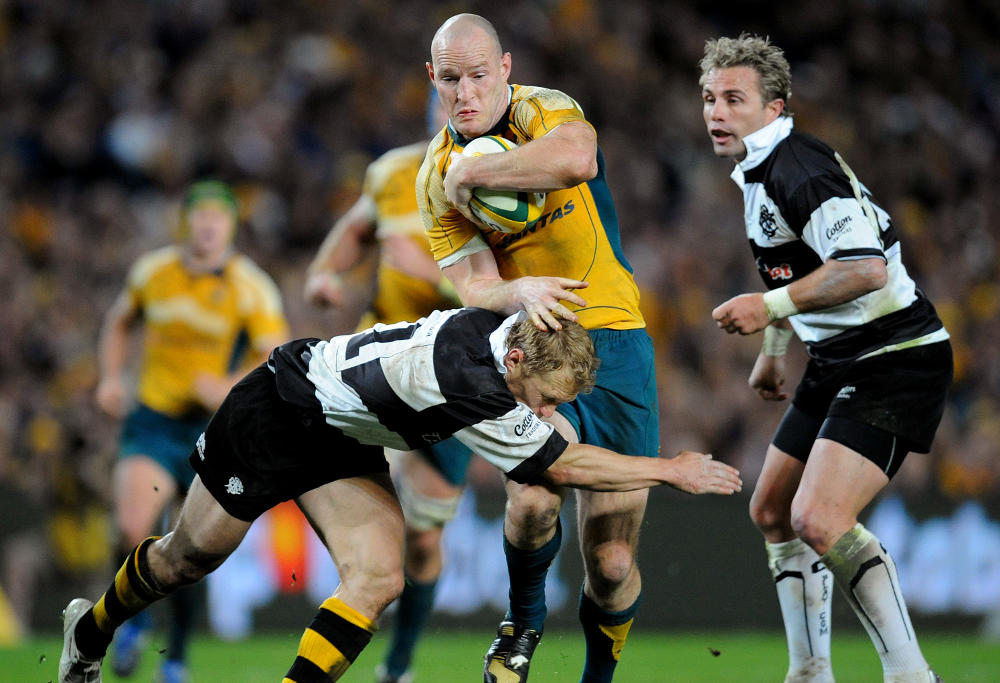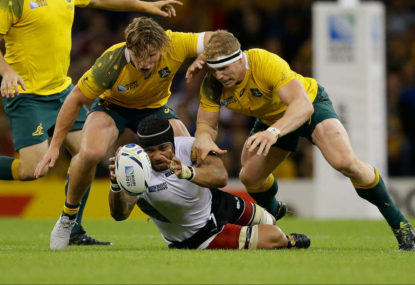It’s always good fun to think about the great power players of our game, and the great power players to have pulled on the Wallabies jersey in the last two decades. It’s a good conversation starter, and from there the hearty debate flows.
In Part 1, I named three of the top six most powerful Australian rugby union players of the past 18 years. There’s a mix of current players and their counterparts from yesteryear.
While picking out three players from the early 2000s wasn’t too tricky, things got a bit harder in trying to apply that same sort of thinking around what constitutes a ‘power player’ among the current generation.
This is harder because the game has moved on so much since the game first went fully professional. By design, all players these days are essentially power athletes, and so picking the outstanding examples isn’t so easy.
But once again, I’ve enlisted the help of Rohan Smith, the former rugby league head coach of the Bradford Bulls and Tonga, and we’ve come up with a top three, one of whom is a modern-day player…
3. David Pocock
Pocock is easily forgotten at the moment, having completed his layoff and research sabbatical in South Africa and now returning to the game with Panasonic in Japan, but he is still very much a part of current Wallabies plans, and will be back on Australian rugby soil in early 2018.
And he absolutely fits this brief.
An amazing specimen of an athlete, one who takes meticulous care of his body – and always has done from a young age – to ensure he gets the best out of himself every time he takes the field.
Strongly built in the upper body, Pocock’s ability to survive the cleanout as he stands over the ball in the ruck is certainly unrivalled in Australia, and has been a world standard for the best part of the decade. His capacity to quickly get to a wide, stable base and operate low to the ground is quite staggering.
More than that, his ability to get down and dirty within a ruck – the proverbial ‘dark places’ often referred to in the modern game – and find a pilfer when there really wasn’t a pilfer on offer, is a skill that has been sorely missed in the three separate year-long absences he had from the game through injury and this year’s sabbatical.
His playing weight remains listed around the 105kg mark, but his impressive build makes him look much better. A definite power player who cannot return to Australian rugby soon enough.

(Photo: AFP)
Rohan says: Pocock has an incredible ability to withstand a hit at the breakdown. His combines core and trunk strength with balance to be able to hold his ground while getting hit and still rip the ball off the opposition. He seems immovable at times!
A collision is Pocock’s friend, and he’s certainly not scared of the gym!”

2. Stirling Mortlock
Mortlock’s injury was the reason it’s Owen Finegan pictured holding up the Super 12 trophy in 2004, when a heartbreaking knee injury ruled him out of the final after what had been a blockbusting season for the big centre.
This was Mortlock’s peak period in the game. At his barnstorming best, perhaps only Tana Umaga rivalled him as the game’s premier outside centre. What made him so effective was pure motion; from the moment Mortlock started his run, to the moment he got the ball, to the moment he first encountered defenders, he just kept accelerating.
Seeing him coming was one thing, stopping was quite another altogether. I’d love to know how many of his career metres were made after contact, because his leg drive and his ability to beat the tackle was just incredible.

(AAP Image/Paul Miller)
Mortlock had a really good read on the game, and superb timing, both in attack and defence. He knew when he needed to hit a hole, and that perfect intercept in the 2003 Rugby World Cup semi-final in Sydney is another great example.
He could put a hit on in defence when he needed to, too, with many a quality midfielder around the globe feeling the effects of the Mortlock shoulder under the ribs.
Rohan says: Rugged! He ran hard and often, catching passes at the line and enjoying putting his body on the line. Mortlock wasn’t just a battering ram; he had subtle late footwork at speed – which made it hard for the defenders to get a solid shot on him.
Mortlock was tough on both sides of the ball. His hard-hitting left shoulder under the ball tackle left many players wondering where their air had gone!
He also possessed a strong left arm fend and had the skill to find a pass to complement the power, as well as strong upper body and lower body to run through tackles. Mortlock had the speed to go the distance for some memorable length of the field tries.
He was also not afraid of the big moment – he kicked some memorable match winning goals!

1. Toutai Kefu
I’ll be honest, this was an easy pick. Toutai Kefu was always going to make the cut in a list like this, and the timeframes involved meant that there really isn’t anyone who would be named before him.
And perhaps the best measure of just how tough and powerful Kefu was in his 60-Test international career, and his more than a hundred caps for Queensland, is that 14 years since his last Test, we’re still crying out for someone to fill his shoes.
Powerfully built, uncompromising, and always ready for hard work, Kefu was the sort of player captains loved. If there was a hit-up needed, he was ready for it. If a tackle had to be made, Kefu was there. He carried with intent, had a great knack of making ground after the initial contact, and could just destroy blokes in defence.
Of course, a power listing like this wouldn’t be complete without Kefu’s magical moment against New Zealand in Sydney in 2001, or evidently, as Google now knows it, the ‘Toutai Kefu try’.

(AAP Image/Dean Lewins)
From a lineout deep on attack with the Wallabies trailing by four, only about seventy seconds left on the clock and therefore in John Eales’ glittering Test career, the Wallabies talk the ball into a lineout drive for a metre or two, before releasing to George Gregan, who immediately went wide to Stephen Larkham.
Larkham ran across field seven metres out, handed off to Kefu now on his inside, and Kefu immediately stepped left, leaving Ron Cribb clutching at air. He then straightened and headed straight for the black dot, bumping off Carl Hayman and Tana Umaga, powering over the line next to the upright carrying Justin Marshall and three other late-arriving All Blacks with him.
It still gives me tingles re-watching now.
“Kefu will never score a more important try,” Gordan Bray exclaimed in commentary. No Gordon, indeed he didn’t. A great player. A powerful player.
Rohan says: A big man who made plenty of memorable crash tackling cover tackles. Wallabies fans will remember him catching kicks and running them back. Running through tackles, falling forward after collisions.
He always came across very strong in the collision area, he was big and heavy, but had the motor to cover the field.
To have the ability to collide, but also the endurance to cover the field – he must have trained at a high level to develop that capacity.

When you really need some extra grunt the Amarok V6 delivers 33kW more power than its competitors, reaching a massive 180kW on overboost. Volkswagen Amarok V6 – the most powerful ute in its class.


































































































